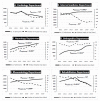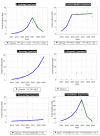Hospital Inpatient Falls across Clinical Departments
- PMID: 34360462
- PMCID: PMC8346045
- DOI: 10.3390/ijerph18158167
Hospital Inpatient Falls across Clinical Departments
Abstract
Background: Inpatient falls are common hospital adverse events. We aimed to determine inpatient fall rates in an urban public hospital and analyzed their characteristics across clinical departments.
Methods: The study was conducted in a 350-bed urban, multi-specialty public hospital in the 2013-2019 period. Patient data were retrieved from the hospital's standardized falls reporting system. Descriptive statistics and statistical tests: chi2 and ANOVA tests with multiple comparison tests (post-hoc analysis) were used. For fall incidence estimation a joint-point regression was applied. p-value of 0.05 was considered as statistically significant for all the calculations.
Results: The highest prevalence of falls was reported in the rehabilitation and internal medicine wards (1.915% and 1.181%, respectively), the lowest in the orthopedic (0.145%) and rheumatology wards (0.213%) (p < 0.001). The vast majority of falls took place in the late evening and during the night (56.711%) and were classified as bed falls (55.858%). The crude incidence rate (cIR) of falls was 6.484 per one thousand hospitalizations. In the 2013-2017 period, an increase in total cIR was observed, reaching the peak value in 2016; it was followed by a slight decline from 2017 to 2019, however, differences in changes were observed between the wards.
Conclusion: Fall rates and trends as well as circumstances of inpatient falls varied significantly among clinical departments, probably due to differences in patient characteristics.
Keywords: elderly patients; fall; fall assessment sheet; hospitalization; risk management.
Conflict of interest statement
The authors declare no conflicts of interest.
Figures



References
-
- Nitz J.C., Johnston V. An argument for a universal definition and method of recording falls. Phys. Ther. Rev. 2014;19:131–135. doi: 10.1179/1743288X13Y.0000000107. - DOI
-
- Enloe M., Wells T., Mahoney J., Pak M., Gangnon R., Pellino T., Hughes S., Leahy-Gross K. Falls in acute care: An academic medical center six-year review. J. Patient Saf. 2005;1:208–214. doi: 10.1097/01.jps.0000195776.91068.93. - DOI
-
- Goodwin M.B., Westbrook J.I. An analysis of patient accidents in hospital. Aust. Clin. Rev. 1993;13:141–149. - PubMed
MeSH terms
LinkOut - more resources
Full Text Sources
Medical

